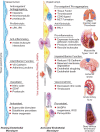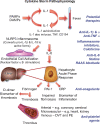COVID-19 is, in the end, an endothelial disease
- PMID: 32882706
- PMCID: PMC7470753
- DOI: 10.1093/eurheartj/ehaa623
COVID-19 is, in the end, an endothelial disease
Abstract
The vascular endothelium provides the crucial interface between the blood compartment and tissues, and displays a series of remarkable properties that normally maintain homeostasis. This tightly regulated palette of functions includes control of haemostasis, fibrinolysis, vasomotion, inflammation, oxidative stress, vascular permeability, and structure. While these functions participate in the moment-to-moment regulation of the circulation and coordinate many host defence mechanisms, they can also contribute to disease when their usually homeostatic and defensive functions over-reach and turn against the host. SARS-CoV-2, the aetiological agent of COVID-19, causes the current pandemic. It produces protean manifestations ranging from head to toe, wreaking seemingly indiscriminate havoc on multiple organ systems including the lungs, heart, brain, kidney, and vasculature. This essay explores the hypothesis that COVID-19, particularly in the later complicated stages, represents an endothelial disease. Cytokines, protein pro-inflammatory mediators, serve as key danger signals that shift endothelial functions from the homeostatic into the defensive mode. The endgame of COVID-19 usually involves a cytokine storm, a phlogistic phenomenon fed by well-understood positive feedback loops that govern cytokine production and overwhelm counter-regulatory mechanisms. The concept of COVID-19 as an endothelial disease provides a unifying pathophysiological picture of this raging infection, and also provides a framework for a rational treatment strategy at a time when we possess an indeed modest evidence base to guide our therapeutic attempts to confront this novel pandemic.
Keywords: Inflammation; Microvasculature; Thrombosis; Cytokine; Endothelium.
Published on behalf of the European Society of Cardiology. All rights reserved. © The Author(s) 2020. For permissions, please email: journals.permissions@oup.com.
Figures


Comment in
-
Understanding COVID-19: in the end it is the endothelium-what else?Eur Heart J. 2020 Aug 21;41(32):3023-3027. doi: 10.1093/eurheartj/ehaa706. Eur Heart J. 2020. PMID: 33216863 Free PMC article. No abstract available.
References
-
- Aird WC. Endothelium. In: Kitchens CS, Kessler CM, Konkle BA, eds. Consultative Hemostasis and Thrombosis, 3rd ed. Philadelphia. PA: W.B. Saunders; 2013. p33–41.
-
- Libby P. The vascular biology of atherosclerosis. In: Zipes DP, Libby P, Bonow RO, Mann DL, Tomaselli GF, eds. Braunwald’s Heart Disease, 11th ed. Philadelphia, PA: Elsevier; 2018. p859–875.
-
- Pober JS, Sessa WC. Evolving functions of endothelial cells in inflammation. Nat Rev Immunol 2007;7:803–815. - PubMed
-
- Libby P. The active roles of cells of the blood vessel wall in health and disease. Mol Aspects Med 1987;9:499–567. - PubMed
-
- Libby P, d Birinyi LK. The dynamic nature of vascular endothelial functions. In: Zilla P, Fasol R, Deutsch M, eds. Endothelialization of Vascular Grafts. Basel: Karger; 1987. p80–99.
Publication types
MeSH terms
Substances
Grants and funding
LinkOut - more resources
Full Text Sources
Medical
Miscellaneous

